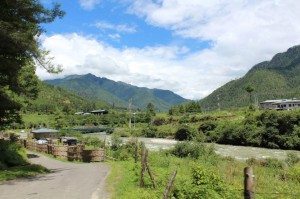
The road towards Takhtshang Monastery
Bhutan
Welcome to Bhutan, a land which is as traditional as it is modern, and as friendly as it is insular. It is a small, landlocked kingdom in the eastern Himalaya, near where the world’s highest mountain range begins to taper off into southern China and far eastern India. If you don’t know much about Bhutan, it’s with good reason. Bhutan was cut off to the outside world until the 1970s – before that, everyone had to hike in (seriously). In the 1970s, with Indian help, Bhutan built an international airport on one of their only pieces of flat land, and one lane roads over the border from near Darjeeling. It was at that point that the
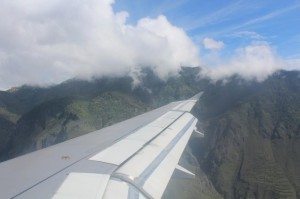
Winging our way into the Paro Valley
Bhutanese realised that they had a choice; either open their doors to mass tourism (a la Thailand’s “McTemple” scene), or pioneer a new form of tourism to be known as ‘high value, low volume’ in which foreigners would pay a premium to stay, but in return be given the most memorable experience of their lives. They chose the latter.
The flight to Bhutan was on Drukair, Bhutan’s official royal airline. As my plane climbed out of Dhaka, the mirror-like floodplains of Bengal reflected the morning sun, and I drew my window shade. A quick meal was served, and I opened my window shade again to see that the waterlogged pancake of Bengal’s hinterland had given way to a rugged, densely forested mountain range. The captain announced that we would begin our descent, and the small jet began to sink towards earth. Bhutan’s only international airport is in Paro, the country’s second largest town, home to 70,000. The airstrip is spectacularly located in a narrow valley, and Drukair’s pilots reportedly undergo a decade of training to land their Airbus A319s at this challenging airfield. No other airline is permitted to operate there, unless a Drukair pilot is present in the cockpit. Paro airport has been described as the world’s scariest airport, although in truth it’s not that scary – but incomparably spectacular.
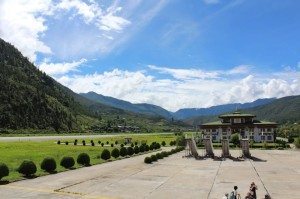
Paro Airport
Once through the clouds, it wasn’t long before the plane was gliding between, rather than over, the mountains. Those forested peaks were now higher than the wings of the plane, and we were getting lower. The plane coasted through the valleys of Bhutan’s western province, following the contours of the land the way a car might.
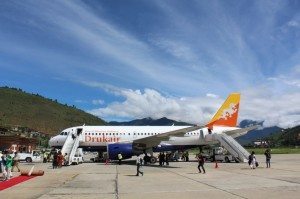
Drukair’s A319 at Paro Airport
No more than a few hundred metres off the ground we passed over a river and a small ridge dotted with farmhouses. With a quick waggle of the wings, the pilot angled the aircraft towards the runway, and we were down. (Click here to watch someone else’s video of the Paro airport landing). As we taxiied towards the terminal, I peered out of the window; oriental-style houses which were thinly scattered across the valley. The plane turned, and a much larger building of the same temple-esque design appeared – that was the international terminal. It quickly became clear that Bhutan was a very different kind of country.
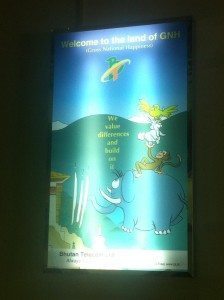
Bhutan values Gross National Happiness over Gross National Product, as this sign in Paro Airport declares
Bhutan’s ‘high value, low volume’ tourism model is perhaps best compared with that of Australia’s Lord Howe Island. Restrictions on foreign investment, a cap on the number of tourists permitted, and compulsory accommodation packages all ensure that Bhutan remains unspoiled, and maintains a certain exclusivity around travelling there. Except for Indians, all foreigners travelling to Bhutan must book a package tour, complete with a local guide and driver (and porter is necessary). This is not done to control tourists, rather to ensure that they fully appreciate and understand the special Bhutanese culture, and don’t accidentally offend anyone in a place where anyone over 40 would remember an era before tourism. Accommodation, meals, drinking water and visas are all included in the package price, which is about A$240 per night. Once in the country, tourists pay for nothing, except soft drinks, alcohol and souvenirs.
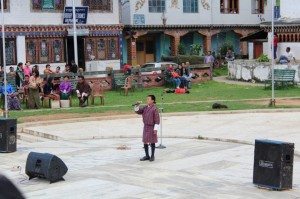
A child wearing a gho at a talent contest near Paro
My guide met me at the airport and we were soon on our way to have morning tea in the town of Paro. Over a quick chai, I got to know my guide and driver – both young men educated in India. They were both wearing gho, the traditional men’s cloak native to Bhutan. As a measure to preserve the fragile culture, the Bhutanese government requires all Bhutanese to wear traditional dress when they go to work, they explained to me. “A bit like how westerners are required to wear a shirt and tie to the office – this is the same thing. It’s like our uniform” they told me. We then jumped back in the car to drive to the base of Takhtshang Monastery, also known as the Tiger’s Nest Monastery.
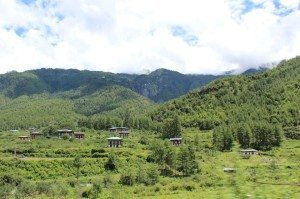
Bhutanese countryside in the Paro Valley
Leaving Paro, the scenery instantly became spectacular. On either side of the valley, the mountains which were so easily navigated by the Drukair jet now seemed imposing, yet not ominous. The forested mountains formed a corridor-like valley floor, along which paddocks were being tended to by old and young Bhutanese in their traditional dress. My guide pointed out a couple of monasteries built on the hillsides. Cows, goats, horses, chickens, dogs, cats – it was as if Noah’s Ark had made a transit stop here and let a few off to roam freely around the emerald green paddocks. In between, rice paddies were full to the brim with their crop.
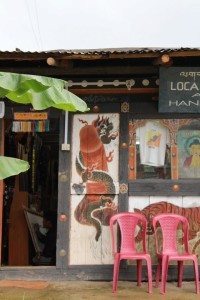
A phallus painted near the doorway of Bhutanese home, to ward off evil spirits
The farmhouses, similar to every building in Paro, were wooden constructions with turreted roofs and elaborately painted windows. Dragons leered out of the walls, while elephants gave piggyback rides to dogs and birds in the riotous paintings. Some houses were adorned with giant paintings of a penis and testicles next to their front doors. “It’s a phallus” said my guide flatly. “Traditionally, people would paint them on their houses to ward off bad omens” he continued, without a hint of amusement. “But the city people – they wouldn’t paint it on their houses” he added with a slight grin. The road followed a gushing river, although we quickly turned off and crossed a bridge which was decorated with multicoloured prayer flags. “To bless the water” I was told by my friendly guide as he pointed downstream towards Paro. “Then the animals and people who drink the water will also be blessed”.
Yep, things work differently in Bhutan.
In the next instalment I’ll describe the feeling of when I first caught sight of the spectacular, cliff-hugging Takhtshang Monastery, and cover what else there is to do in this gorgeous piece of heaven known as Bhutan.
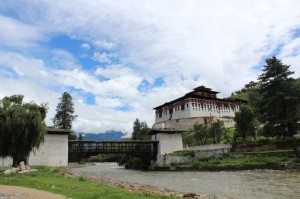
The Paro Monastery
When to go
Peak tourism period in Bhutan is from March to June, as the temperature climbs, and from September to November, after the monsoon recedes. July and August can be rainy, although not unpleasant, and December, January and February see the country covered in a blanket of snow – gorgeous, but very cold and some roads close.
Essential Stats
Culture shock: 8/10
Language difficulty: 4/10
Quality of food: 8/10
Cost: 9/10
Physical demand: 9/10
Advice and warnings
Bhutan is an incredibly safe place in which to travel – the dangers posed by altitude sickness, hiking fatigue and avalanche far outweigh any potential crime or political unrest. That said, do keep an eye on your belongings just in case – this might look like utopia, but you’re still on planet Earth.
Check Smart Traveller or the British Foreign Office for more comprehensive warnings.
Visas
Australians and Pakistanis need a visa in Bhutan, but it is pre-arranged by the travel agency and then collected at Paro airport on arrival. I used the excellent and very friendly Phuentshok Tours and Treks, and would happily recommend them – they organised everything! The price and processing of the visa is worked out on the basis of length of stay.
Indians may visit Bhutan and obtain a visa on arrival, provided that their passport has a further six months of validity.
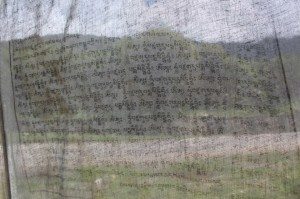
Prayer flag in Bhutan
Getting there and around
No foreign airline regularly flies to Bhutan – only Drukair, which flies to a bunch of regional ports.
Melbourne and Sydney
For Australians the easiest option is via Bangkok. Drukair’s Bangkok – Paro flight costs US$799 return, inclusive of taxes. This will be organised along with the tour package. Drukair doesn’t have interline agreements with any other airlines, so you’ll need to disembark from your flight to Bangkok, collect your baggage and re-check in for Drukair onwards to Bhutan. Be sure to leave enough time – a day or two preferably.
THAI flies to Bangkok at least once daily from each of Melbourne and Sydney. All THAI flights arrive and depart from Survanabhumi International Airport (Bangkok’s main airport).
Melbourne (from $1079 return)
Sydney (from $1096 return)
Discount airline Air Asia flies from Melbourne to Bangkok via Kuala Lumpur from $513 return, while Sydney to Bangkok via Kuala Lumpur is from $547 return. Note that Air Asia uses Don Mueang Airport in Bangkok, the older airport which is now popular with discount airlines. Discount airline Jetstar flies directly from Melbourne to Bangkok with fares starting from $563 return. They operate into the main Bangkok airport at Survarnabhumi.
Lahore
Lahoris heading to Bhutan are best to transit through Kathmandu. Flights on Drukair from Kathmandu to Paro cost US$443 return. PIA flies from Lahore to Kathmandu via Karachi several times a week from PKR 59,067 return. Don’t forget to apply for a multiple entry Nepal visa from the Embassy of Nepal in Islamabad (from US$25).
Chennai
Indian citizens can fly directly from Kolkata to Paro from US$430 return. Indigo and Jet Airways fly from Chennai to Kolkata several times daily.
All transport in Bhutan will be organised as part of the tour.
Accommodation
All accommodation is included in the cost of the visa, and that costs the same regardless of where you stay, so it makes sense to ask for the best option when booking.

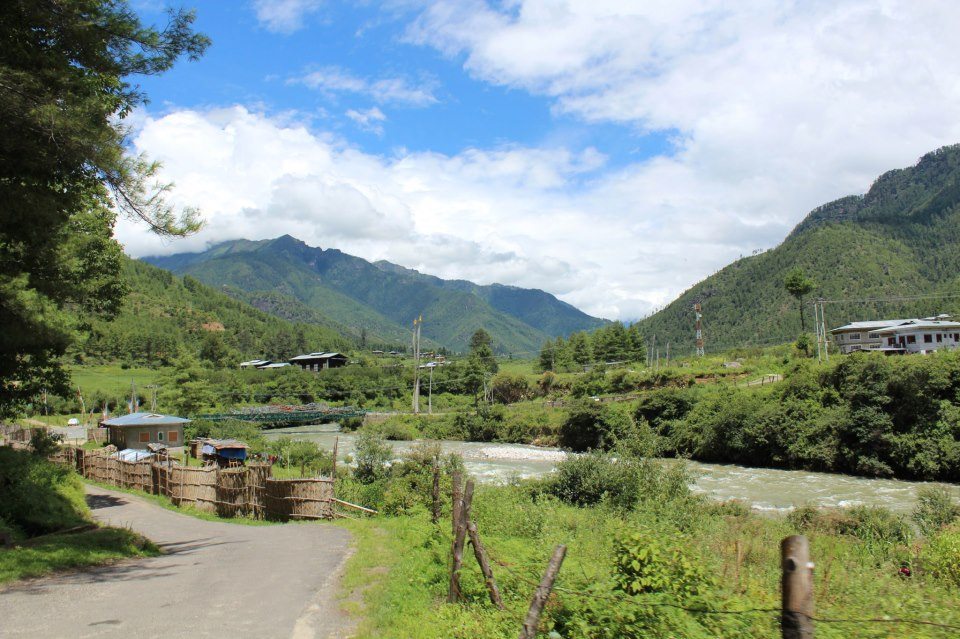



Thanks Tim for a great post. I’ve heard of Bhutan so many positive things and some of my friends told me a lot of great stories from the road when travelling there. I’ve never made it there though. It’s on my bucket list! I like the fact it is a small, landlocked kingdom in the eastern Himalaya so I guess the landscape is just breath-taking! Wow, it’s also so cheap which is awesome for us – tramps :)!
Thanks for reading Agness! Actually, Bhutan isn’t that cheap at all – $200 to $250 per day as a rule, but everything is included (transport, food, visa, guide, attractions) so it’s decent value, if not low-cost travel.
I just loved the descriptions of bhutan. Any place that values gross national happiness over gross national product gets my vote. Well done!
Ours too! Stay tuned for more posts about Bhutan in the coming weeks! And thanks for reading!! 🙂
A lovely post on Bhutan! Has been high on my list within Asia. Paro Valley seems like a great treat for nature lovers!
Pretty much all if Bhutan is a treat for nature lovers!! It’s just so beautiful- I wish I could go back there soon!!